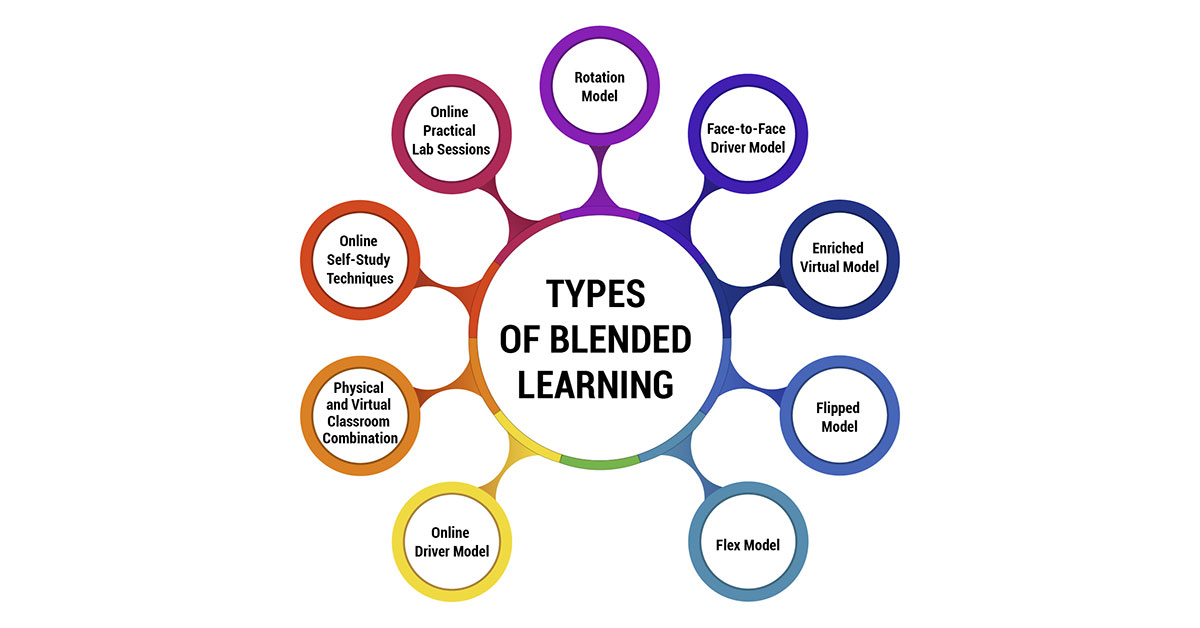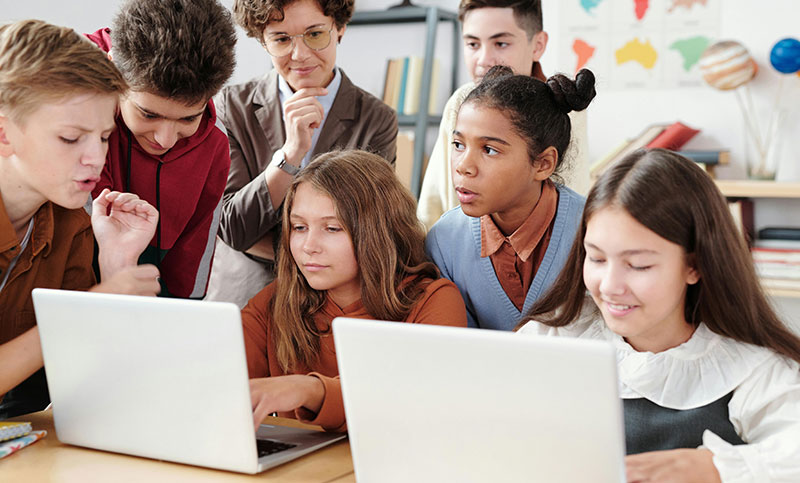Blended Learning Unveiled: Diverse Models and their Benefits
July 19, 2024As we transition back to in-person interactions, it's tempting to shift all educational programs entirely online. However, completely discarding face-to-face training might not be the best approach. Instead, consider a blended learning strategy, which merges the strengths of traditional classroom instruction with modern technological advancements, offering a balanced and enriched learning experience.
Blended learning has gained significant traction and is esteemed by educators for its numerous benefits. This approach combines conventional teaching methods with digital resources, making learning more immediate, contextual, and engaging. As the concept of blended learning evolves, we've moved from traditional classrooms and corporate offices to online learning environments, remote work setups, and digital workplaces. This evolution allows learners to experience trainer-led lessons and coaching sessions alongside self-guided, interactive activities that provide hands-on training and support within their workflow.
The traditional notion of "learning" has expanded beyond the confines of a classroom. The digital age has introduced numerous innovations, previously unimagined, that significantly enhance the learning process. Technology now plays a crucial role in education, and without integrating educational technology (edTech), learning wouldn't reach its full potential. "Blended Learning" revolutionizes conventional teaching, providing a fresh perspective through e-learning methodologies, helping students excel academically and develop essential skills. By adopting a blended learning strategy, educators and organizations can offer a comprehensive, engaging, and effective learning experience that leverages the best of both in-person and digital education.
Comprehending Blended Learning
Blended learning is an educational approach that merges traditional in-person instruction with online learning, creating a comprehensive and flexible learning experience. For instance, a learner might start with an online course to grasp the basics of a subject and then attend an in-person seminar for hands-on practice and expert interaction. This method leverages both conventional education methods like conferences, seminars, and workshops, and digital resources such as webinars, online quizzes, videos, blog posts, surveys, eBooks, and tutorials.
The popularity of blended learning has surged, especially as personal and professional activities shift online post-COVID-19 pandemic. It is mainly because, blended learning can also include various formats such as rotating between learning stations, participating in flipped classrooms where students learn new content online before class, and engaging in enriched virtual models with a mix of online and occasional in-person sessions unifying different types of learners, whether they thrive in a traditional classroom setting or prefer semi-autonomous, computer-based training.
Types of Blended Learning
Various models exist to cater to diverse learning needs and preferences of blended learning to create a dynamic and flexible learning environment. Here's an overview of the main types of blended learning:

-
Rotation Model
The rotation model involves learners cycling through a fixed schedule of different learning modalities. For example, students may engage in face-to-face instruction, participate in instructor-led webinars, and complete online quizzes. This structure offers a balanced approach, allowing learners to benefit from both in-person and digital learning experiences. -
Face-to-Face Driver Model
In this approach, traditional classroom instruction is the primary method, supplemented by online resources. Teachers provide direct instruction and utilize online materials to support students who need additional practice or time to master concepts. This model closely mirrors conventional classroom settings while incorporating the flexibility of digital tools. -
Enriched Virtual Model
The enriched virtual model focuses predominantly on online content, with mandatory in-person sessions or virtual instructor-led classes. This model is particularly effective for educating a geographically dispersed or digitally-focused workforce. It allows learners to engage with material at their own pace while still benefiting from periodic direct interactions with instructors. -
Flipped Model
In the flipped model, learners first access instructional content online, such as video lectures or readings, outside of class. Classroom time is then dedicated to activities that apply and reinforce this knowledge through discussions, group projects, and exercises. This approach promotes active learning and greater student engagement during face-to-face sessions. -
Flex Model
The flex model grants learners significant autonomy over their learning paths. Students access online content and resources at their convenience, with in-person support available as needed. This model is ideal for self-motivated learners who prefer to study at their own pace, with instructors acting as facilitators to provide guidance and address challenges as they arise. -
Online Driver Model
This model maximizes learner autonomy by allowing participants to complete coursework entirely online at their own pace. While optional communication with instructors is available, it is not required for completing the training. This model suits learners who are highly self-motivated and comfortable with independent study. -
Physical and Virtual Classroom Combination
This blended approach integrates both physical classroom sessions and virtual learning. Teachers can adjust the ratio of in-person to online sessions based on the course requirements. This method helps maintain engagement by varying the learning environment and reducing the monotony of traditional classroom settings. -
Online Self-Study Techniques
Students enroll in online courses to study independently. This approach encourages learners to explore subjects of personal interest beyond their regular academic curriculum, fostering a culture of lifelong learning. -
Online Practical Lab Sessions
Instructors conduct practical lab lessons online, broadcasting demonstrations to students. While ensuring safety precautions are followed, this method allows learners to observe and understand practical applications remotely, enhancing their comprehension of theoretical concepts.
Blended learning's flexibility and adaptability make it a powerful tool for modern education, offering a variety of models to suit different learning styles and needs.
Benefits of Blended Learning
Blended learning offers numerous advantages for both faculty and students. Here are the top benefits of this approach:
-
1. Effort and Time Savings
Blended learning techniques, including e-learning, reduce the workload for teachers by streamlining lesson delivery and management. This efficiency allows educators to focus more on student engagement and personalized instruction. -
2. Flexibility in Teaching and Learning
Students can access lessons and course materials at any time, providing the flexibility to learn at their own pace. This approach accommodates diverse schedules and learning preferences, making education more accessible. -
3. Access to Extensive E-Content
With blended learning, students have instant access to a vast array of e-content. This digital resource pool supports skill development and enhances the learning experience through a variety of multimedia formats. -
4. Personalized Communication
Educational tools and learning management systems facilitate better teacher-student collaboration, even in virtual settings. These platforms enable personalized feedback and communication, bridging the gap between online and face-to-face interactions. -
5. Enhanced Student Performance Evaluation
Online tools allow teachers to monitor student engagement, attendance, and academic progress more effectively. This continuous evaluation helps educators identify areas where students may need additional support. -
6. Informed Decision Making
Analytics dashboards in e-learning software provide insights into student performance and learning gaps. This data-driven approach enables teachers to tailor their instructional strategies to better meet student needs. -
7. Higher Student Engagement
Blended learning increases student engagement by incorporating diverse instructional methods, including interactive online modules and in-person activities. This variety keeps students interested and motivated. -
8. Greater Productivity Levels
Blended learning methods enhance productivity for both teachers and students. Students learn more efficiently, and teachers can deliver content in a more streamlined manner, achieving better educational outcomes in a shorter time. -
9. Encourages Innovation
This approach encourages students to think creatively and embrace innovative problem-solving techniques. The integration of technology in learning builds a culture of innovation and critical thinking. -
10. Long-Term Societal Benefits
Well-educated and skilled students contribute to the economic and social growth of society. Blended learning equips students with the knowledge and skills needed to make meaningful contributions to their communities. -
11. Merging Traditional and Digital Learning
Blended learning leverages the strengths of both in-person and online education, catering to different learning styles. It breaks the monotony of traditional methods and enhances engagement through a mix of multimedia, presentations, and real-life projects. -
12. Cost-Effective and Improved ROI
Blended learning reduces training costs by minimizing the need for physical resources and travel. While developing high-quality online content incurs initial expenses, the overall cost is lower compared to traditional methods. This approach also improves productivity, leading to a higher return on investment. -
13. Facilitates Feedback Collection
Blended learning platforms simplify the process of gathering feedback through online quizzes and tests. This continuous assessment helps organizations monitor training effectiveness and make necessary adjustments. -
14. Self-Paced Learning
Employees and students can learn at their own pace, accommodating their individual schedules and preferences. This flexibility supports balanced learning, enhancing comprehension and retention. -
15. Customizable Learning Experience
Blended learning allows for personalized training programs that meet specific needs. Information can be presented in various formats, making it accessible and engaging for all learners. -
16. Scalability
Blended learning is easily scalable, accommodating growing numbers of learners without significant increases in cost or logistical challenges. This scalability is particularly beneficial for organizations with a global reach. -
17. Increased Knowledge Retention
By engaging multiple senses and reinforcing training through various methods, blended learning helps ensure that information is retained more effectively. This holistic approach supports long-term knowledge retention.
Conclusion
In the dynamic realm of education, blended learning stands out as a versatile and effective approach that harmonizes traditional teaching methods with contemporary digital tools. By seamlessly integrating face-to-face interactions with online resources, blended learning caters to the diverse needs of learners and educators alike. This innovative model not only promotes flexibility and accessibility but also develops deeper engagement, personalized learning experiences, and enhanced educational outcomes. As we embrace the possibilities of blended learning, we pave the way for a future where education is more adaptive, interactive, and conducive to lifelong learning.




